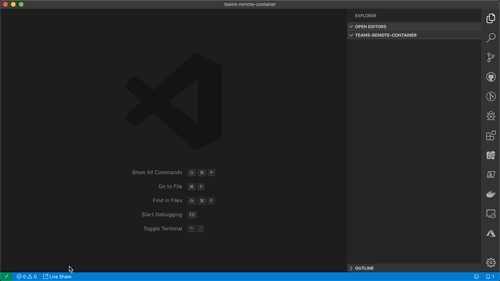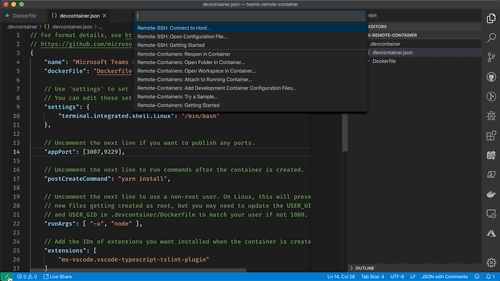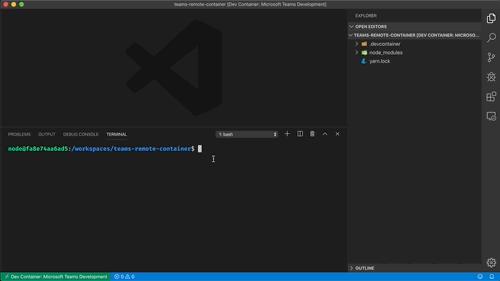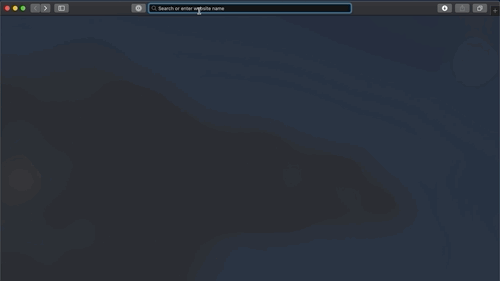How to use Visual Studio Code Remote Containers to develop Microsoft Teams apps
30 October 2019This post will guide you through the process of creating and configuring a remote development container within Visual Studio Code for Microsoft Teams app development. The ‘Visual Studio Code Remote - Containers’ extension lets you use a Docker container as a full-featured development environment.
Prerequisites
This guide assumes that you have Docker already installed configured to use Linux containers and is running, see Docker Install for more detail.
Create the project folder
First we need to create an empty folder for our project.
- Open a terminal session
- Create a new folder for your project
mkdir teams-remote-container
- Change into project directory
cd teams-remote-container
- Open folder in Visual Studio Code
open .
Install VSCode Remote Development Extension Pack
To enable the remote development functionality within Visual Studio Code you will need to install an extension from Microsoft, see Remote Development Extension Pack on the marketplace.
- Open Extensions marketplace from the Side Bar
- Search for
Remote Development - Install the extension
Add Development Container Configuration Files
Next step is to create a base remote container configuration within the empty project.
- Open the command palette
- Search for and select the
Remote-Containers: Add Development Container Configuration Files...command - From the
Add Development Container Configuration Filesmenu, typenodeand selectNode.js (latest LTS) & Typescript

After completing the above steps you will find a new folder in your project folder called .devcontainer which contains two files, devcontainer.json and Dockerfile.
A prompt will be displayed asking if you want to reopen the project in a container, ignore this
Update the Dockerfile
Next step is to update the base Dockerfile to use a lighter base Docker image Node.js and include the dependencies required for Microsoft Teams app development.
- Open
Dockerfile - On line 6, replace
FROM node:ltswithFROM node:slim - On line 37, replace
&& npm install -g tslint typescript \with&& npm install -g tslint typescript yo gulp-cli generator-teams \ - Save the file
Update devcontainer.json
Next step is to change the VSCode configuration file which VSCode will use when instrucing Docker to build and start the container.
- Open
devcontainer.json - Update
nameto fromNode.js (latest LTS) & TypeScripttoMicrosoft Teams Development - Uncomment line 14 and replace
"appPort": []with"appPort": [3007,9229], - Uncomment line 17
- Uncomment line 22 and replace
"runArgs": [ "-u", "node" ],withrunArgs": [ "-u", "node" ], - Save the file
Reopen the project
Now that we have configured our remote container, we are now ready to reopen the project inside the Container.
- Open the command pallete or click the Remote Container icon (
><) in the bttom left of the status bar - Search for and select
Remote-Containers: Reopen in Container
VSCode will instruct Docker to build the Dockerfile, generating an image with all the required dependencies installed, reopen the project within the context of the container and open an interactive bash terminal session.

Scaffold your Microsoft Teams project
Now that the container is running, we can run commands inside it to scaffold our new project.
You do this by executing yo teams from the terminal session to start the Microsoft Teams Yeoman generator.

After your project has been created, run npm run-script debug to start the ngrok server. Opening a browser window and navigating to http://localhost:3007 will display the debug web server running within the container.

Update devcontainer.json to apply project environment variables in container
When a new project has been created a .env file is created, as we are running in a container we need to tell Docker to use this file to update the environment variables within the running container.
This step is important for when you want to package your app as environment variables are used in the packaging process
- Open
devcontainer.json - On line 22, replace
runArgs": [ "-u", "node" ]withrunArgs": [ "-u", "node", "--env-file=.env"] - Save file
- Open the command pallete, search for and select
Remote-Containers: Rebuild Container
Closing connection
When you are done, you can close the project and the container by clicking on the DevContainer icon in the bottom left of the status bar and selecting Close remote connection
